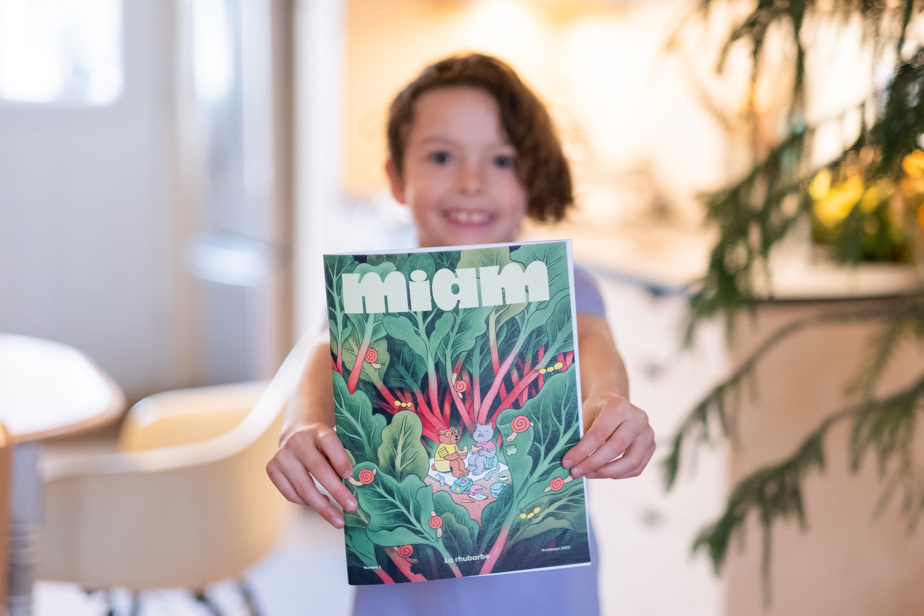Would the children around you know how to describe a potato plant? And you ? Are you hesitating? You are not alone, says Anna Demay, editor of Yum, the first Quebec youth magazine devoted to food. When she enjoys asking people about the origin of the potato, she sees question marks appear in their eyes (and the author of these lines is no exception).
However, the potato is one of the vegetables most consumed by Quebecers, according to a report by the National Institute of Public Health of Quebec published in 2019.
In this era where it is possible to eat what you want at any time of the year, we eat food without really being interested in its origin, notes Anna Demay. “We are disconnected from nature. And that scares me,” admits the one who has a master’s degree in food history and who works in the wine industry.

PHOTO CHARLES WILLIAM PELLETIER, SPECIAL COLLABORATION
Anna Demay, editor of Yum
According to her, adults and children would benefit from acquiring greater food literacy. Recognizing healthy foods, knowing how to grow fruits and vegetables, understanding the grocery store supply network, learning how to cook and knowing ways to avoid food waste are a few examples of elements encompassed by this concept that is very dear to Anna Demay.
This finding echoes a document published a few weeks ago by the Lab-school team in which Ricardo Larrivee, Pierre Lavoie and Pierre Thibault also insist on the importance of food literacy.
“Part of the solution”
“But how do we collectively ensure that all this knowledge is passed on to our young people? wondered the mother of two children, aged 9 and 2. Her thinking led her to create Yuma new children’s magazine dedicated to food, the first issue of which appeared in April.
I think that Yum, this is the beginning of part of the solution. You have to take the time to teach these notions to children.
Anna Demay, editor of Yum
If the aim of the magazine is education, Anna Demay insists on the fact that it is not a school exercise book. Through games, stories, comic strips, fact sheets and recipes, she and her team of collaborators want to show young people in elementary school that food, “it’s trippy and that it can also be fascinating than Pokémon.
In the spring issue dedicated to rhubarb, we learn in particular that it is a perennial plant, that it is native to Asia and that it has medicinal properties. But over the pages, we also discover a fictional story, written by Fanny Britt and illustrated by François Simard, whose main theme is friendship and not the strawberry-rhubarb pie cooked by the two heroines. “Food is sometimes a watermark in the magazine. It exists like that in our lives, and it’s okay to talk about it like that too, ”explains Anna Demay.
Awakening to food
Published four times a year, Yum will explore a specific food in each issue. “We have only one parameter: the food. It’s sick, what comes out of it. The creative process is so exciting”, says with great enthusiasm the one who, for this project, surrounded herself with various artists, including Thom, Cathon and Benoît Tardif.
With this magazine, Anna Demay hopes to pique children’s curiosity and make them want to take an interest in what they eat. “We awaken them to lots of things: sport, theatre, music… For me, food is as important as all that. »
A local flavored lemonade
-

PHOTO CHARLES WILLIAM PELLETIER, SPECIAL COLLABORATION
Throughout the pages of Miam magazine, children not only discover a food, but they are also invited to cook it. In the first issue, there is a delicious lemonade of rheum rhabarbarum, the scientific (and rather funny) name for rhubarb. Here is the recipe that Anna Demay’s son, Victor, generously agreed to prepare for the photographer of The Press.
-

PHOTO CHARLES WILLIAM PELLETIER, SPECIAL COLLABORATION
In a saucepan, pour 4 cups (1 L) of diced rhubarb, 4 cups (1 L) of water and 1/2 cup (125 ml) of white sugar or maple syrup.
-

PHOTO CHARLES WILLIAM PELLETIER, SPECIAL COLLABORATION
Mix everything and bring to a boil.
-

PHOTO CHARLES WILLIAM PELLETIER, SPECIAL COLLABORATION
Simmer for 10 minutes, stirring occasionally. Then, remove from heat and let cool.
-

PHOTO CHARLES WILLIAM PELLETIER, SPECIAL COLLABORATION
Pour the liquid into a pitcher by running it through a strainer. Squeeze the rhubarb pieces well with a spoon to extract as much juice as possible.
-

PHOTO CHARLES WILLIAM PELLETIER, SPECIAL COLLABORATION
Put the pitcher in the fridge for at least 30 minutes, then serve in glasses with ice cubes. Add a few mint, basil or coriander leaves, if desired.
-

PHOTO CHARLES WILLIAM PELLETIER, SPECIAL COLLABORATION
Health !
1/7
